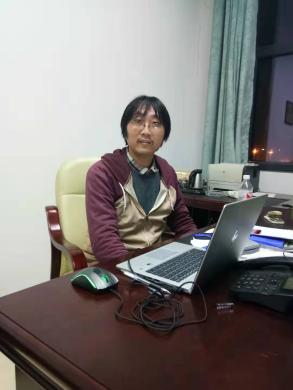N Gao*,L.B. Li,T.L. Shen,Y. Yang,L.T. Sun,H.W.Zhao
Institute of Modern Physics, Chinese Academy of Sciences, 730000, LanZhou, China
Abstract: To develop and apply nuclear energy safely is one possible solution to meet the requirement of clean energy in China. Until now, to extend the lifetime of the existing nuclear power plants and develop the next generation nuclear power system becomes one of key topics in China after several decades of safe use of nuclear energy. For fusion reactors, after joining the ITER project, the new design of CFETR has also been approved for its further building in China. However, to select and develop the radiation resistant materials used in nuclear plants is one of key factors for fission and fusion reactors. Thus, how to evaluate the related materials becomes necessary and important for further development of nuclear energy.
In this work, a new high-throughput implantation platform for materials has been designed and built based on a low energy high intensity accelerator facility (LEAF) developed in Institute of Modern Physics, CAS, as shown in Fig.1. In this new facility, the temperature of implantation target is controlled through a water cooling system, which can automatically change the speed of water and its temperature based on implantation ion intensity and ion energy. The high intensity ensure the implantation area up to 10cm×10cm. The position, shape and thickness of samples can be adjusted freely for their implantation uniformly. Thus, for sample with area of 1cm×1cm, 100 samples can be implanted simultaneously, satisfying the high-throughput requirement. The implantation current can also be changed up to several hundred microamps, which in fact can be further increased depending on the water cooling system. In addition, LEAF has provided different experimental factors, including different beams, single, double or tri-beam implantation and energy of ions, to meet the requirement of different purposes.
Based on this platform, we have demonstrated its application by implantation of tungsten and irion with H and He ions. The experimental results indicated that within one week, more than 100 samples can be implanted up to different dose under different temperatures, which confirmed the high-throughput properties of this new platform for selection and evaluation of materials used in nuclear facilities.
Keywords: radiation damages;ion implantation;accelerator;low energy high intensity; high-throughput
材料高通量辐照实验装置-LEAF辐照平台及应用
高宁*,李利斌,申铁龙,杨尧,孙良亭,赵红卫
中国科学院近代物理研究所,730000,兰州,甘肃
摘要:随着国家对清洁能源供给要求的不断提高,安全发展与和平利用核能成为一种可能的解决方案。到目前为止,核裂变能在我国已经经过了几十年的发展应用,目前面临反应堆延寿的关键问题,同时发展下一代核能装置也逐渐提上日程;而聚变能的发展,随着我国加入ITER合作项目,目前也进入了设计和建造我国自主研发的聚变堆(CFETR)阶段。不管是裂变堆和聚变堆,选择及发展合适的抗辐照损伤的材料,都是保证核能长期安全利用的关键,因此,如何高效地筛选与评估并在此基础上发展相关材料,成为抗辐照损伤材料研发的关键问题。
在本研究中,我们针对上述关键问题,基于低能量高流强加速器装置(LEAF),搭建了首个能够开展材料高通量辐照实验的终端,如图1所示。其中辐照靶采用液态冷却方式,可以根据辐照流强进行适当调控液态流速和温度,完成动态温度调控;辐照靶均匀辐照面积达10cm×10cm,并采用了调幅控制样品位置方法,能够固定不同大小、厚度及形状的样品,对于面积为1cm×1cm大小的样品,单次辐照样品数目达100片,可以实现高通量辐照;辐照流强根据实验要求,可以达到几十到几百微安,甚至可以提供毫安量级的辐照(取决于液态冷却能力及样品能够承受的温度);同时,LEAF装置能够提供扫描及扩束两种均匀辐照方式,满足不同辐照实验目的。目前,LEAF材料高通量辐照平台能够提供单束、双束及三束同时辐照实验,如H/He/重离子混合束,粒子能量为0.5MeV/u,随着LEAF的不断升级,其提供的粒子能量范围会逐渐增加,满足辐照实验。

图1:LEAF装置及辐照终端,其中高通量辐照靶采用液态冷却装置,辐照均匀面积达10cm*10cm
基于此高通量辐照装置,到目前为止,已经进行了钨合金和钢在不同H/He离子单束及混合束下的辐照实验,经过测试,在1周时间内,可完成100块辐照样品不同辐照剂量(~几十dpa)不同H/He含量的辐照实验,温度可控,满足相应的实验要求,验证了此高通量辐照装置的可行性。
关键词:辐照损伤;离子注入;加速器;低能强流;高通量

山东大学前沿交叉科学青岛研究院教授,博导。2007年清华大学材料科学与工程系硕士,2011年瑞士联邦洛桑理工大学材料科学与工程学院博士,2012年加入中国科学院近代物理研究所,先后担任副研和研究员,材料计算模拟组组长,2016先入选中科院青促会,先后在美国UCLA,LANL和PNNL做高级访问学者,2019年加入山东大学。材料协会计算分会委员,主持面上基金2项,科学院及所级基金2项,参与科技部项目1项,发表Nature Materials, Scripta Materialia, Journal of Nuclear Materials等40余篇。
Email: ning.gao@impcas.ac.cn,